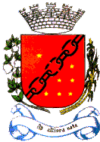Sete Lagoas
| Sete Lagoas | |||
|---|---|---|---|
| Municipality | |||
| Município de Sete Lagoas Municipality of Sete Lagoas | |||
|
Downtown Sete Lagoas, with a view from Lagoa Paulino, one of the seven lagoons which name the city. | |||
| |||
|
Nickname(s): Cidade dos Sete Lagos Encantados (City of Seven Lakes Enchanted), Cidade Nascida Para o Alto, (Born To High City) | |||
 | |||
 Sete Lagoas Localization of Sete Lagoas in Brazil | |||
| Coordinates: 19°27′57″S 44°14′49″W / 19.46583°S 44.24694°WCoordinates: 19°27′57″S 44°14′49″W / 19.46583°S 44.24694°W | |||
| Country |
| ||
| Region | Southeast | ||
| State |
| ||
| Founded | November 30, 1880 | ||
| Government | |||
| • Mayor | Márcio Reinaldo Moreira (2013-2016) | ||
| Area | |||
| • Total | 537.476 km2 (207.521 sq mi) | ||
| Elevation | 766.73 m (2,515.52 ft) | ||
| Population (2013) | |||
| • Total | 227,571 | ||
| • Density | 423.41/km2 (1,096.6/sq mi) | ||
| • Demonym | ’’sete-lagoano’’ | ||
Sete Lagoas (meaning 'Seven Lagoons' in Portuguese) is a city in the Brazilian state of Minas Gerais. The municipal area is 537 km² while the population was 217,506 in 2007.
Location
Sete Lagoas is situated about 70 kilometres from Belo Horizonte, the capital of Minas Gerais. The BR 040 motorway connects Sete Lagoas with Belo Horizonte and the national capital Brasília. The altitude is 761 metres above sea level. It is surrounded by the following municipalities: Araçaí, Funilândia, Prudente de Morais, Capim Branco, Esmeraldas, Inhaúma, Paraopeba, and Caetanópolis.
Climate
According to data from the meteorological station of the municipality, the average temperature of the city between the years 1961 to 1990 was 20.9°C.
The coldest month (July) had an average of 17.5°C while the hottest month (February) had an average of 23.0°C.
According to a table, the weather station in the municipality already registered a temperature of 0.6°C.
Distances to other cities in Minas Gerais
- Montes Claros: 360 km.
- Uberaba: 1000 km.
- Uberlândia: 564 km.
- Tres Marias: 181 km
- Governador Valadares: 263 km.
- Juíz de Fora: 236 km.[1]
- Funilandia: 18 km
Statistical Micro-region of Sete Lagoas
Sete Lagoas is also a statistical micro-region with 20 municipalities: Araçaí, Baldim, Cachoeira da Prata, Caetanópolis, Capim Branco, Cordisburgo, Fortuna de Minas, Funilândia, Inhaúma, Jaboticatubas, Jequitibá, Maravilhas, Matozinhos, Papagaios, Paraopeba, Pequi, Prudente de Morais, Santana de Pirapama, Santana do Riacho, and Sete Lagoas. In 2000 the population of this area was 341,568 inhabitants in a total area of 8,560.40 km².[2]
Economic activities
The economy is based on services, industry and some agriculture. The GDP in 2005 was R$2 billion 800 million, with 1 billion 120 million from services, 1 billion 250 thousand from industry, and 17 million from agriculture. There were 824 transformation industries in 2005 with 15,000 workers. Heavy industry was important with 23 factories producing mainly pig iron.[3] There is an Iveco-Fiat plant, which opened in 2001, that produces trucks and vans.[4]
Health and education
In 2005 there were 51 public and 53 private health clinics. There were 5 hospitals with 315 beds. Educational needs were met by 86 primary schools (29 private), 30 middle schools (9 private), and 56 pre-primary schools (36 private).[3] In higher education there was the private Centro Universitario de Sete Lagoas, the private Faculdade Cenecista de Sete Lagoas, a campus of the private Faculdade Promove de Sete Lagoas, the private Faculdade Ciências da Vida - FCV, the private Faculdade Sete Lagoas de Minas Gerais - FSLMG, and the private Faculdade Setelagoana de Ciências Gerenciais - FASCIG. See Mundo Vestibular. The city also has a campus of the Universidade Federal de Sao João Del Rei where approximately 300 students are attending Food and Agronomic Engineering in a partnership with the Embrapa Maize and Sorghum.
History
Evidence of pre-Columbian presence has been found in the Gruta Rei do Mato (Cave of the Forest King).
From around 1700, colonists entered Minas Gerais in search of gold, gems and diamonds. Nowadays, the Santa Luzia quarter is unofficially still called "o garimpo" (meaning "the goldmine").
Between 1780 and 1867, the name 'Sete Lagoas' was used for several regional types of administrations. The municipality of Sete Lagoas was founded in 1867.
Although "Sete Lagoas" means "Seven Lakes", there are currently more than seven lakes in Sete Lagoas (10 within the urban perimetre, 17 in the municipality). Some were dug out while others became part of the town when the town expanded. There are, however, 7 'official' lakes according to a municipal law from 1989. These are: Lagoa da Boa Vista, Lagoa da Catarina, Lagoa da Chácara, Lagoa do Cercadinho, Lagoa José Felix, Lagoa do Matadouro and Lagoa Paulino.

Food
Food is an important element of the culture of Minas Gerais. In Sete Lagoas, two dishes can be found that are hardly found elsewhere: Galopé and Muchacho. Galopé is a dish of chicken (galo) and pork feet (pé de porco). Muchacho is also composed of chicken and pork but it also contains cheese.
Sports
Democrata Futebol Clube is a soccer club based in Sete Lagoas. The club plays its home matches at the Arena do Jacaré ("Alligator Arena", so named because of Democrata's mascot; the official name is Joaquim Henrique Nogueira stadium). Other football clubs are Ideal Sport Club, Bela Vista Futebol Clube and América Futebol Clube.
In 2010 and 2011, Arena do Jacaré serves as a home stadium for Atlético Mineiro, Cruzeiro and América-MG, as both Belo Horizonte stadia - Mineirão and Independência - are going through reforms.
References
External links
| Wikimedia Commons has media related to Sete Lagoas. |
-
 Sete Lagoas travel guide from Wikivoyage
Sete Lagoas travel guide from Wikivoyage - Official homepage (Portuguese)

